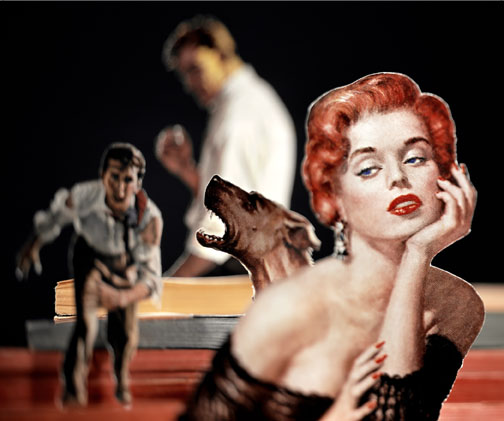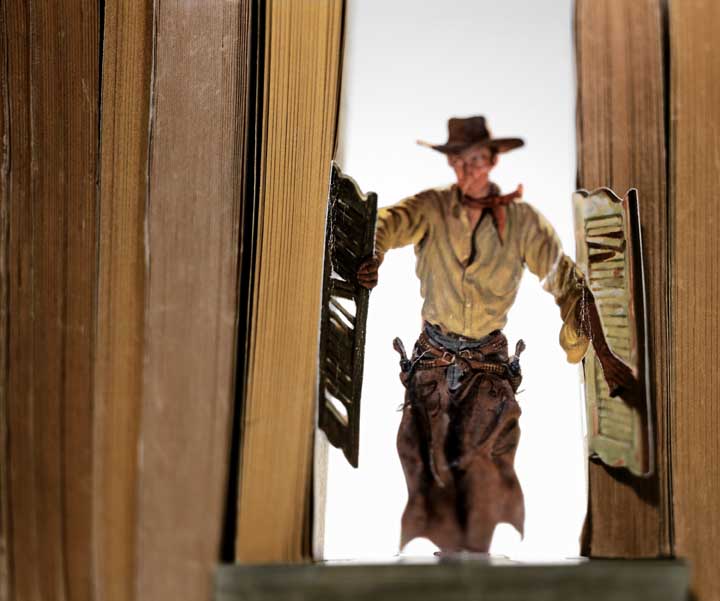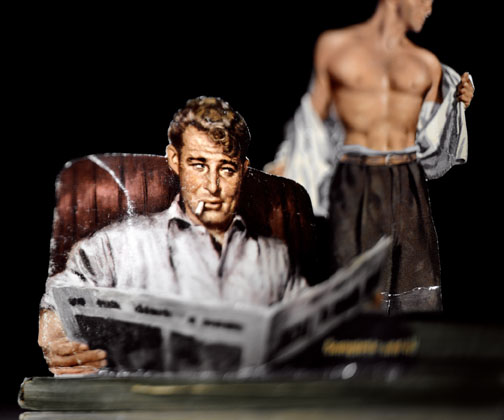Books, Broads, and Bohos: Thomas Allen at Thomas Barry
Mason Riddle reviews the Thomas Allen show at Thomas Barry Fine Arts. Allens career in illustration is illustrious; catch him in publications around the country.



Thomas Allen’s photographs are recognized, perhaps, more by the readership of The New Yorker (March 5, 2007), GQ (March 2007), Harpers (2005) and The Virginia Quarterly Review (cover, 2005), or such books as Blink, Freakonomics: Why We Want You to Be Richand Giving Gays the Business than by the fine arts, gallery-romping crowd. (Of course, the two are not mutually exclusive.) But if you have missed these Allen sightings over the last few years, his work can be seen at Thomas Barry Fine Arts en masse, instead of one or two photographs at a time as in a magazine.
Allen’s current show of eighteen C-prints, all measuring 20 x 24 inches, is a continuation of his obsessive exploration of mid-century pulp fiction novels through the clever device of pop-up tableaux. For each image, Allen has literally dissected one or more books, carefully cutting out the figures of the protagonists, accomplices, and victims illustrating each story. The books and figures are carefully arranged in small-scale vignettes, like miniature stage productions, and then photographed. Allen uses the camera’s depth of field to create a more implied, exaggerated depth, bringing some figures into sharp focus and leaving others blurred. The technical catch is that all of the figures are still attached to the books from which they came, creating a latter-day trompe l’oeil effect, a seemingly impossible feat.
Taking his visual cues from the actual book, whose titles are often legible in the photographs, such as The Gun Tamer, Split the Jackpot, Dark Hunger and All the Way Down, Allen creates his own provocative, steamy tableaux that variously suggest murder, fear, desire and deception. The figures act out their ominous or reprehensible actions and scenarios – a touch of the ass here, a fist to the jaw there – but always within the physical framework of the books to which they are still attached. Thus the books define the actual physical space within which the figures function; they are the architecture that provides structure to Allen’s narratives.
No matter the tabloid activity, it is projected in an in-your-face sort of way. Drama, aggression and eroticism run high, basic values run very low. In Split the Jackpot, a blonde bombshell next to the book of the same title, and a slot machine, lifts her shirt to reveal two very pert breasts. In Maneater, a Rita Hayworth femme fatal in an off-the-shoulder black dress smolders, cunningly, in the foreground. Behind her is a nasty-looking hound baring his teeth, and several books like a stage for two male figures, one of whom appears to be running for his disheveled life. In Distraction, a well-coifed man reads the newspaper in the foreground; behind him a six-pack-abs hunk is taking off his shirt. In Fury, two well-dressed women are in a fistfight.
Compositionally, one of the strongest images in the show is Tall Stranger. Here, a “don’t-screw-with-me” looking cowboy, wearing chaps and multiple holsters slung low, bursts through swinging saloon doors. We have no idea who he is looking for, or about to kill. What is so compelling about this reductive image is that Allen has created a powerful architectural structure from the book that frames and isolates the cowboy against a pale atmospheric background. Although small in scale, the setting appears monumental.
Through his labor-intensive process, Allen animates his figures, giving them, literally, an off-the-page dimension and reality. He is also constructing his own bodice-ripping, gun-slinging visual narratives, which are only tangentially related to the books’ actual narratives. In essence, he is co-opting a book’s title and illustrations, creating his own stories, manipulating them as he sees fit. So there is no confusion about fiction and reality – meaning the actual book and his reconstructed tableaux – Allen has photographed some of his vignettes on the tabletop cutting board that bears the knife marks of the book’s dissection.
What does it mean to create new provocative narratives out of old provocative ones? Perhaps nothing earthshaking here, other than Allen’s process keeps his figures connected to two different worlds: the world of pulp fiction based on the written word and a hidden, two-dimensional illustrative life, and the world of pulp fiction based entirely on the image, excepting the book’s title in some images, which takes on life and new meaning in a three-dimensional construct. In a sense, Allen is both author and illustrator. These are curious, involved works that function like a game where the viewer needs to puzzle together a story line based on the information provided. While these photographs are thoughtful and very clever, they are best appreciated and are most powerful when seen in small doses, one or two at a time. Viewed in great numbers, as in a gallery setting, they give up some of their visual and psychological impact.